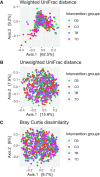Effect on gut microbiota of a 1-y lifestyle intervention with Mediterranean diet compared with energy-reduced Mediterranean diet and physical activity promotion: PREDIMED-Plus Study
- PMID: 34020445
- PMCID: PMC8408861
- DOI: 10.1093/ajcn/nqab150
Effect on gut microbiota of a 1-y lifestyle intervention with Mediterranean diet compared with energy-reduced Mediterranean diet and physical activity promotion: PREDIMED-Plus Study
Abstract
Background: The Mediterranean diet is a well-recognized healthy diet that has shown to induce positive changes in gut microbiota. Lifestyle changes such as diet along with physical activity could aid in weight loss and improve cardiovascular risk factors.
Objectives: To investigate the effect of an intensive lifestyle weight loss intervention on gut microbiota.
Methods: This is a substudy of the PREDIMED-Plus (Prevención con Dieta Mediterránea-Plus), a randomized controlled trial conducted in overweight/obese men and women (aged 55-75 y) with metabolic syndrome. The intervention group (IG) underwent an intensive weight loss lifestyle intervention based on an energy-restricted Mediterranean diet (MedDiet) and physical activity promotion, and the control group (CG) underwent a non-energy-restricted MedDiet for 1 y. Anthropometric, biochemical, and gut microbial 16S rRNA sequencing data were analyzed at baseline (n = 362) and 1-y follow-up (n = 343).
Results: IG participants had a weight loss of 4.2 (IQR, -6.8, -2.5) kg compared with 0.2 (IQR, -2.1, 1.4) kg in the CG (P < 0.001). Reductions in BMI, fasting glucose, glycated hemoglobin, and triglycerides and an increase in HDL cholesterol were greater in IG than in CG participants (P < 0.05). We observed a decrease in Butyricicoccus, Haemophilus, Ruminiclostridium 5, and Eubacterium hallii in the IG compared with the CG. Many genera shifted in the same direction within both intervention groups, indicating an overall effect of the MedDiet. Decreases in Haemophilus, Coprococcus 3, and few other genera were associated with a decrease in adiposity parameters in both intervention groups. Changes in Lachnospiraceae NK4A136 were positively associated with changes in MedDiet adherence.
Conclusions: Weight loss induced by an energy-restricted MedDiet and physical activity induce changes in gut microbiota. The role of MedDiet-induced changes on the host might be via short-chain fatty acid producing bacteria, whereas with energy restriction, these changes might be modulated with other mechanisms, which need to be explored in future studies. This trial was registered at http://www.isrctn.com/ISRCTN89898870 as ISRCT 89898870.
Keywords: Mediterranean diet; energy restriction; gut microbiota; obesity; weight loss.
© The Author(s) 2021. Published by Oxford University Press on behalf of the American Society for Nutrition.
Figures





References
-
- Lippert K, Kedenko L, Antonielli L, Kedenko I, Gemeier C, Leitner M, Kautzky-Willer A, Paulweber B, Hackl E. Gut microbiota dysbiosis associated with glucose metabolism disorders and the metabolic syndrome in older adults. Benef Microbes. 2017;8:545–56. - PubMed
-
- Crovesy L, Masterson D, Rosado EL. Profile of the gut microbiota of adults with obesity: a systematic review. Eur J Clin Nutr. 2020;74:1251–62. - PubMed
-
- Duncan SH, Lobley GE, Holtrop G, Ince J, Johnstone AM, Louis P, Flint HJ. Human colonic microbiota associated with diet, obesity and weight loss. Int J Obes. 2008;32:1720–4. - PubMed
Publication types
MeSH terms
Substances
Associated data
LinkOut - more resources
Full Text Sources
Other Literature Sources
Medical

